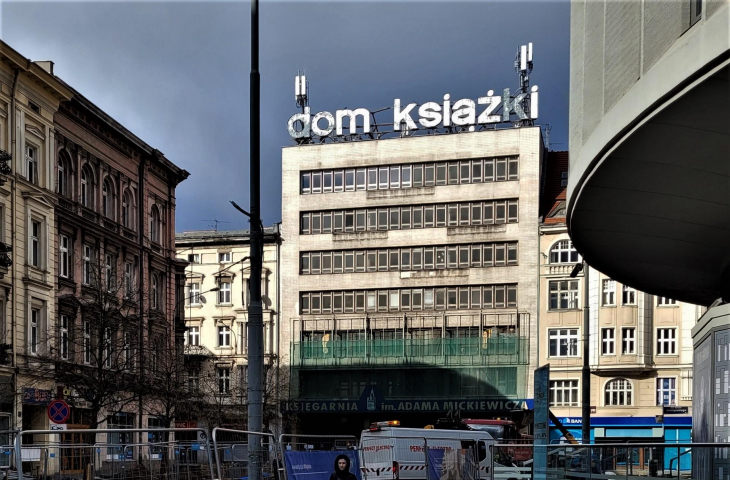More and more modernist office buildings and stores are waiting for their second life. But, contrary to the ideas of modernism, flexible adaptation in the spirit of re-use is not easy. There are far more announcements than real action. Will it be different with plans for the former "House of Books" in Poznan? Among other things, apartments are to be built in it.
The modernist building of the former bookstore and office building Dom Książki in Poznan has stood completely deserted for the last ten years, and is haunted by its degraded appearance (and, until recently, by advertisements) opposite the renovated icon of Poznan modernism—Okrąglak (designed by Marek Leykam, 1948-55). For less than a year the building has had a new owner, an experienced developer, Constructa Plus, which intends to redevelop the building and adapt it for, among other things, residential purposes. At the same time, it stipulates that these will not be pathological "micro-apartments," but apartments of normal size. According to Poznan's "Gazeta Wyborcza", Constructa Plus is now seeking a new building permit (the previous one, for the former owner, does not correspond to the current intentions). Joanna Janowicz of Constructa Plus, quoted by "Gazeta," reports that the developer plans to locate
six to seven apartments on each floor. The ground and underground floors will house commercial premises. We are convinced that the residential function will bring life back to the "House of Books". In the spaces of the building we plan accents that will remind us of the history of this unique place.
The former "House of Books" at the closure of 27 Grudnia Street in Poznan—In the foreground, the street is being rebuilt as part of the Center Project
late Corbu?
If the owner's intentions succeed, Poznan's downtown will benefit strongly. After all, the "plomba" (designed by Bogdan Bednarek, Zygmunt Łomski), completed in 1975, is strongly exposed in the space of the center. It stands at a disorderly and nameless space (before the war it was Gwarny Square), next to Okrąglak, at the intersection of Gwarna and 27 Grudnia Streets, closing the perspective of the latter with a simple façade. The layout and tectonics of this façade were considered by architect and architectural historian Piotr Marciniak as a
a belated reminiscence of Le Corbusier's pre-war designs for the Porte Molitor building (according to "Experiences of Modernism. Architecture and urban planning of Poznań during the communist era").
The clearly marked first floor arcade, strip windows and stone cladding give the building a timeless character and—despite its larger scale—corresponds well with neighboring tenements. Adapted for, among other things, residential purposes (a very sensible idea in this location), the building has a chance to bring life back to this part of the city, which is currently undergoing a protracted renewal of the downtown street space as part of the so-called "Center Project.
not so flexible
The question arises, however, to what extent it will be possible to preserve the original structure of the building , which is almost half a century old, and how much its volume will be increased at the expense of the attractive courtyard. Experience shows that adaptations of former office buildings or department stores are difficult and costly. Problems include the load-bearing capacity of the structure, the quality of the materials used, the dimensions and number of technical and communication risers (which do not comply with today's standards). Sometimes the revaluation goes exemplarily—such as in the case of the neighboring Okrąglak. It was successfully renovated more than a decade ago, preserving the original structure and elevations (revaluation and office adaptation proj: RKW Rhode Kellerman Wawrowsky Poland, 2011).
Former "House of Books," building from 1975. Poznan, Gwarna Street, on the right the arcade of the renovated Okrąglak can be seen
photo: Jakub Głaz
More often, however, modernist architecture undergoes very significant transformations (sometimes only favorable ones, vide: the 2015 remodeling of the Foksal Gallery Foundation headquarters in Warsaw). This applies not only to less significant buildings, but even in such icons as Warsaw's former Central Department Store (also called "Smyk", designed by Zbigniew Ihnatowicz, Jerzy Romański, 1951 ) on Jerozolimskie Avenue, built several years ago basically from scratch, preserving parts of the original facades.
This is significant, because—thanks to, among other things, free projection, columnar structures, technical risers and curtainwall elevations—20th-century architecture was supposed to be easy to adapt to new purposes. Meanwhile, many investors would find it more profitable to demolish and erect a new building. Fortunately, it is more difficult to do so in a conservation zone, so that heavily exploited and decapitated but interesting buildings are under as such care. Worse, however, is that their revaluation and adaptation for new purposes are often delayed.
The former "House of Books," a building from 1975. Poznan, Gwarna Street—View from the courtyard
photo: Jakub Glaz
unwanted skyscrapers
In Poznan, it is not only the case of Dom Książki, but also part of the skyscrapers of the so-called Alfa—the former shopping and office center on Swiety Marcin Street. In recent years it has been possible, not without technical problems, to adapt one of the five high-rise buildings into a hotel called Altus (2019). Despite the announcements, the adaptation of another now-defunct skyscraper into a private dormitory, on the other hand, is dragging on very long. This has been influenced not only by the lengthy redevelopment arrangements, but also by the financial and serious legal problems of yet another investor.
Former commercial and retail complex "Centrum", so called Alfa, Poznań, Swiety Marcin St.—A high-rise building with a mast was to be adapted into a dormitory.
Photo: Jakub Głaz
Among the owners of the neighboring three skyscrapers, there is no desire for changes either. According to unofficial information, it is known that it is also difficult to find buyers. So far, the owner of one of the office buildings, who is no longer satisfied with the standard and size of the skyscraper, has not found a buyer .
Skyscraper of the "Center" ("Alfa") complex intended for a dormitory, rear entrance
Photo: Jakub Głaz
Besides, it is not only post-war modernism that is waiting for a second life in Poznań. Last year, PKO BP Bank sold its 1937 building on Wolności Square. The new owner does not disclose if and what new function this already historic, successful and timeless building designed by Jadwiga Dobrzyńska and Zygmunt Loboda will have.
The former PKO BP bank, a 1937 edifice, Wolności Square, Poznań.
Photo: Jakub Glaz
We can only hope that its adaptation will take place as quickly and efficiently (although with greater respect for the architecture) as last year's conversion to a hotel of the former BGK bank standing opposite (designed 1938, Wacław Kłyszewski, Eugeniusz Mokrzyński, Jerzy Wierzbicki). Otherwise, another modernist building haunting downtown Poznań with dark windows, deteriorating facade and boarded-up doors will arrive.











































